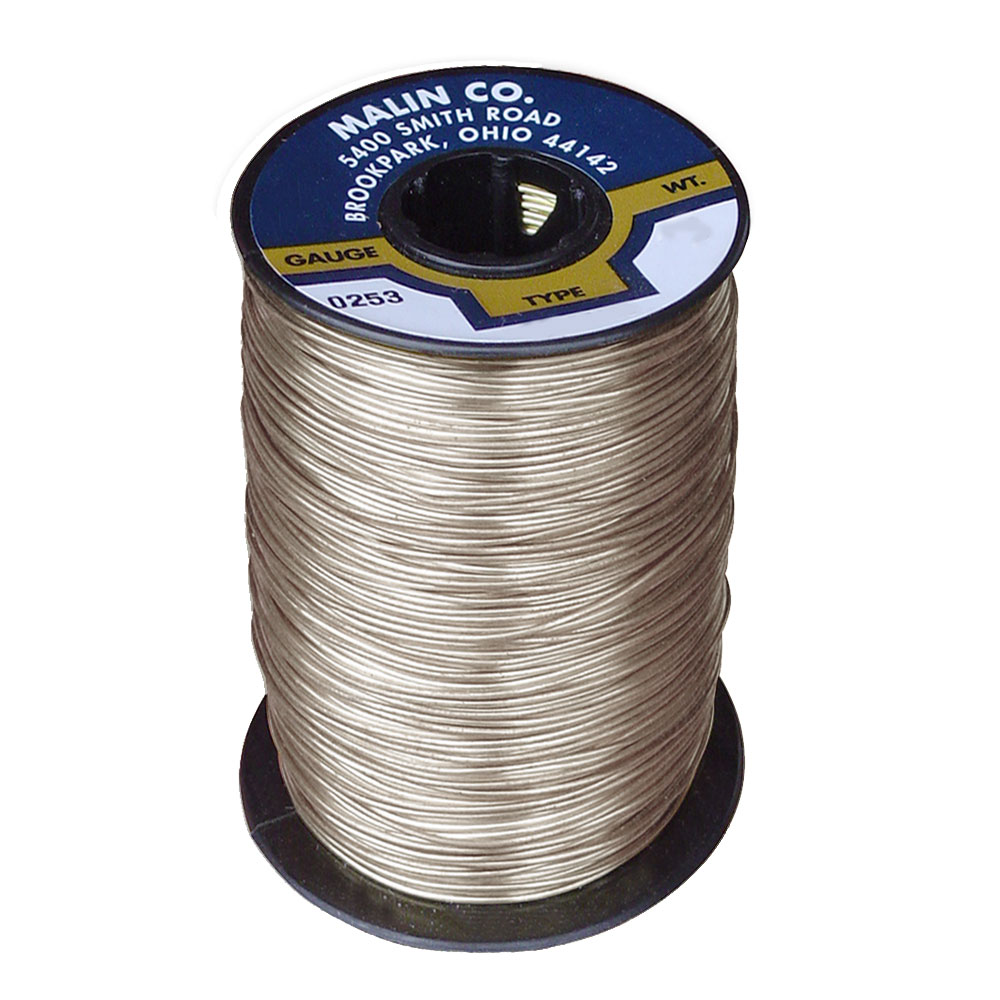Wholesale Stainless Steel Wire Spools | ASTM A580
| Part Number | Nominal Diameter |
|---|---|
| NASM / MS20995C15 ASTMA580 | .015 |
| NASM / MS20995C20 ASTMA580 | .020 |
| NASM / MS20995C21 ASTMA580 | .021 |
| NASM / MS20995C25 ASTMA580 | .025 |
| NASM / MS20995C32 ASTMA580 | .032 |
| NASM / MS20995C41 ASTMA580 | .041 |
| NASM / MS20995C47 ASTMA580 | .047 |
| NASM / MS20995C51 ASTMA580 | .051 |
Stainless Steel Wire | Stainless Steel Lockwire
Since 1884, Malin Co. has been a trusted name in manufacturing stainless steel wire, lockwire, and tie wire. Rest assured, our stainless steel wire complies with ASTM A580 standards.
Tempers
- Annealed
- Intermediate
- Spring
Finishes
- Matte
- Nickel Coated Brite
- Soap
Malin Co. Wire stainless steel wire is available, 1/4 lb spools or in a blue color-coded can for easy identification. Our handy can degrade like paper canisters against grease and corrosive materials.nister won’t
*Please note: There is a $125 minimum on bulk wire orders, lead time quoted with order.
Also available in our handy 1lb canister.
Stainless Steel Wire Services
We work to give our customers the product they need with the presentation they deserve.
Straightened and Cut Wire– From .006′ diameter to .177′ diameter and lengths from .250′ to 10ft. Length and diameter tolerances quoted upon request.
Electro Polished and Clean Wire – We offer diameters as fine as .006” to .041” diameter on spools. The most commonly supplied wire is the 300 series of stainless steel.
Wire Forming – Malin has also developed the ability to shape and form wire in all types of materials and configurations. No quantity is too small. We will set up and run both production and prototype quantities.
Wire Drawing of aluminum, brass, copper, stainless steel, and nickel alloys. Diameters down to .0016” and up to .250” diameter. Malin Co. can also draw and process customer-supplied wire as well.
Barcoding
Also available in our handy 1-lb canister
Bulk Stainless Steel Wire FAQs
What Is Stainless Steel Wire Used For?
Stainless steel wire has a wide range of applications due to its durability, corrosion resistance, and strength. Some common uses include:
- Construction: Stainless steel wire is used in construction for various purposes, including reinforcing concrete structures, suspending ceilings, and creating wire mesh for concrete reinforcement.
- Jewelry: Fine and durable stainless steel wire is often used in jewelry making, especially for items like necklaces, bracelets, and earrings.
- Cookware: Some kitchen utensils and cookware use stainless steel wire for handles or as part of the construction due to its resistance to corrosion and heat.
- Fencing: Stainless steel wire is used in the construction of fences and enclosures, providing a strong and corrosion-resistant material for boundary and security applications.
- Agriculture: In agriculture, stainless steel wire can be used for trellising in vineyards or orchards, providing support for plants as they grow.
- Medical Devices: Some medical devices, such as surgical instruments and dental appliances, use stainless steel wire for its strength, corrosion resistance, and biocompatibility.
- Automotive Industry: Stainless steel wire is used in various components of automobiles, including springs, cables, and fasteners, due to its strength and corrosion resistance.
- Crafts and DIY Projects: Stainless steel wire is popular in crafts and DIY projects, whether for creating sculptures, wire art, or other creative endeavors.
- Marine Applications: Given its corrosion resistance, stainless steel wire is often used in marine environments for applications like rigging, cables, and hardware.
- Electrical Wiring: Stainless steel wire may be used in specialized electrical applications where its properties are advantageous, such as in corrosive environments.
It’s important to note that there are different grades of stainless steel, each with its own set of properties. The selection of the appropriate grade depends on the specific requirements of the application.
How Long Does Stainless Steel Wire Last?
The lifespan of stainless steel can vary depending on several factors, including the specific grade of stainless steel, the environmental conditions it’s exposed to, and how well it’s maintained. In general, stainless steel is known for its durability and corrosion resistance, which contribute to a long service life. Here are some key factors that influence the longevity of stainless steel:
- Grade of Stainless Steel: There are different grades of stainless steel, each with varying levels of corrosion resistance and durability. Common grades include 304, 316, and 316L. Higher-grade stainless steels generally offer better corrosion resistance and a longer lifespan.
- Environmental Conditions: The environment in which the stainless steel is placed plays a significant role. Harsh environments with high levels of salt, humidity, or pollutants can accelerate corrosion. Stainless steel is more resistant to corrosion than many other materials, but it is not completely immune, especially in extreme conditions.
- Maintenance: Regular maintenance can help extend the lifespan of stainless steel. This may include cleaning to remove contaminants, applying protective coatings, and addressing any damage or corrosion promptly.
- Proper Fabrication and Installation: The way stainless steel components are fabricated and installed can impact their longevity. Proper welding, for example, is important to maintain the corrosion resistance of stainless steel.
- Intended Use: The application and use of stainless steel also affect its lifespan. For instance, stainless steel used in marine environments or in aggressive chemical processing may have different requirements compared to stainless steel used in a less demanding setting.
While it’s challenging to provide a specific number of years for the lifespan of stainless steel, it is not uncommon for well-maintained stainless steel to last several decades or even longer. Regular inspection and appropriate care can help ensure that stainless steel retains its properties and continues to perform well over time.
Is Stainless Steel Wire Hard To Work With?
Working with stainless steel wire presents some challenges due to its hardness, strength, and resistance to bending. The material is generally harder than alternatives like copper or aluminum, making it more difficult to shape and requiring robust tools. Stainless steel’s strength and resistance to bending, especially in thicker gauges, can pose challenges during manipulation.
Cutting stainless steel wire may be more challenging than cutting softer materials, necessitating the use of high-quality cutting tools specifically designed for stainless steel. Additionally, stainless steel has a tendency to work harden, meaning it becomes less malleable and harder as it is bent. To counter this, periodic annealing, involving heating and slow cooling, may be necessary to restore flexibility.
The corrosion resistance of stainless steel, while beneficial, can complicate processes like soldering or welding, requiring specialized equipment and techniques. The surface finish of stainless steel wire varies, impacting both appearance and handling.
Despite these challenges, working with stainless steel wire is common in various fields. Beginners may find it helpful to start with thinner gauges and gradually progress to thicker ones as they gain experience. Using appropriate tools, lubricants, and safety precautions can contribute to a successful and rewarding experience when working with stainless steel wire.









